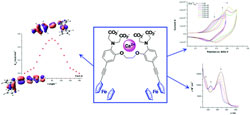Publication
717
Dalton Trans. , 41, 14257-14264, 2012
DOI:10.1039/C2DT31830J
|
|
|
|
|
 |
Water-soluble, redox-active organometallic calcium chelators |
|
|
|
|
Koyel X. Bhattacharyya, Leïla Boubekeur-Lecaque, Issa Tapsoba, Emmanuel Maisonhaute, Bernd Schöllhorn† and Christian Amatore
Department of Chemistry, UMR 8640 CNRS-ENS-UPMC, Ecole Normale Supérieure, 24 rue Lhomond, 75005 Paris, France
† Present adress : Laboratoire d’Electrochimie Moléculaire, Unité Mixte de Recherche Université−CNRS No. 7591, Université Paris Diderot, Sorbonne Paris Cité, Bâtiment Lavoisier, 15 rue Jean de Baïf, 75205 Paris Cedex 13, France
This paper describes a new series of organometallic water-soluble chelators combining a redox moiety (ferrocene) and a selective Ca2+ chelator (BAPTA) separated by an ethynyl bridge. We report the synthesis and characterization of organometallic derivatives of the BAPTA chelator featuring one (2a) and two ferrocenyl (2b) moieties. Single crystal X-ray structural analysis on these chelators revealed unexpected conformations for the ferrocenyl substituent with respect to the phenyl ring of the BAPTA unit. DFT calculations on a model system of the ferrocenyl-ethynyl-BAPTA molecule were carried out to evaluate the energy separation between the two limiting conformations observed experimentally in the solid state, and to check the effective electronic communication between the binding pocket and the redox probe. The binding affinity of 2a–b for Ca2+, as probed by UV-Vis and cyclic voltammetry, revealed distinct behaviors in the presence of a metal ion depending on whether BAPTA is substituted by one or two ferrocenyl group. |

